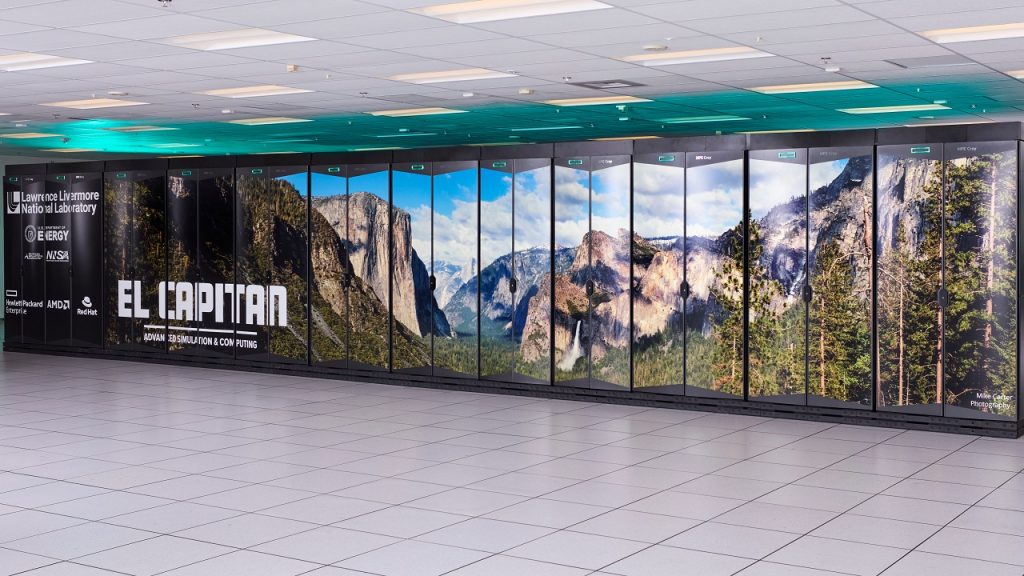The latest Top500 list, published on June 6, 2025, has revealed an interesting trend in the realm of high-performance computing, particularly showcasing the prowess of AMD-based systems. This 65th edition of the rankings highlights a significant absence of new entrants from China and emphasizes the performance of supercomputers utilized by major players in the AI sector, including OpenAI and xAI. As the race for computational supremacy continues, AMD has claimed the top two spots, signaling a notable shift in the landscape of supercomputing.
Top Performers in the Latest Rankings
The AMD Instinct MI300A-powered El Capitan emerged as the world’s most powerful supercomputer, boasting an astonishing Rmax performance of 1.7 FP64 ExaFLOPS. This achievement positions El Capitan at the pinnacle of the supercomputing hierarchy, followed closely by the AMD-equipped Frontier, which recorded 1.353 ExaFLOPS, and the Intel-based Aurora with 1.012 ExaFLOPS. All three systems are operational under the auspices of U.S. Department of Energy laboratories, underscoring the robust infrastructure of American high-performance computing.
Germany’s Jupiter Booster, based on Nvidia’s GH200 platform, made a strong debut as the world’s fourth-most powerful supercomputer, achieving Rmax performance of 0.793 ExaFLOPS. It is followed by Microsoft’s Azure Eagle system, which secured the fifth spot with 0.561 ExaFLOPS.
Technical Specifications and Performance Metrics
El Capitan, situated at Lawrence Livermore National Laboratory, excels not only in raw performance but also in energy efficiency, achieving 58.9 GigaFLOPS per watt. This supercomputer operates on AMD’s fourth-generation EPYC processors and Instinct MI300A accelerators, integrated into an HPE Cray EX255a framework comprised of over 11 million cores with the HPE Slingshot interconnect.
Remarkably, El Capitan leads not only in the High Performance Linpack (HPL) benchmark but also in the High Performance Conjugate Gradients (HPCG) list with a performance measure of 17.1 PetaFLOPS, as well as in the HPL-MxP mixed-precision benchmark, where it achieved 16.7 ExaFLOPS. This multifaceted performance underscores the capabilities of AMD’s architecture in delivering both high throughput and efficient processing.
Meanwhile, the system known as Frontier, located at Oak Ridge National Laboratory in Tennessee, employs AMD’s third-generation EPYC CPUs, and Radeon Instinct 250X accelerators. It operates with over 8.6 million cores and ranks third in the HPCG benchmark with 14.05 PetaFLOPS.
The Aurora system, based in Illinois, comprises Intel Xeon CPU Max and Data Center GPU Max components (aka Ponte Vecchio), contributing to its performance of 1.012 ExaFLOPS in HPL and 11.6 ExaFLOPS in HPL-MxP benchmarks. This highlights Intel’s continuous efforts in the supercomputing sector.
Market Landscape and Geopolitical Implications
An analysis of the June 2025 Top 500 list underscores AMD’s increasing dominance in the supercomputing market, given that it powers two of the highest-performing systems and five out of the top ten machines. In contrast, Intel still leads in terms of the sheer number of deployed systems, with processors featured in 294 of the 500 systems compared to AMD’s 173. Nvidia continues to gain traction, showing early adoption of its Arm-compatible Grace Hopper architecture across 13 systems.
The geopolitical landscape is also shifting, as the United States expanded its numerical lead with 175 systems featured in the Top 500 ranking, while China has seen a stark decline, now only presenting 47 systems. The implications of these changes highlight the U.S.’s strategic initiative in enhancing computational capabilities amid rising tensions.
Energy Efficiency and Future Outlook
The efficiency of supercomputers is becoming an increasingly critical factor in their evaluation. Germany’s JEDI system tops the energy efficiency chart at 72.73 GigaFLOPS per watt, followed by France’s ROMEO-2025 with 70.91 and Adastra 2 at 69.1, all harnessing BullSequana XH3000 infrastructure. In contrast, El Capitan and Frontier ranked lower in terms of energy efficiency despite their superior performance. This discrepancy indicates a complex relationship between peak performance and energy consumption.
As the supercomputing landscape evolves, the competitive dynamics will likely influence both technological advancements and policy decisions regarding high-performance computing, where nations will invest in further enhancing their computational capabilities. With AI and machine learning applications on the rise, the demand for powerful supercomputers seems poised to increase, driving further innovations in the field.
As we move forward, the need for energy-efficient technologies and solutions that balance performance with sustainability will shape the future of supercomputing. Supercomputers like El Capitan and Frontier not only set benchmarks but also inspire future architectures that prioritize both performance and environmental considerations.
Quick Reference Table
| Supercomputer | Rmax Performance (ExaFLOPS) | Location |
|---|---|---|
| El Capitan | 1.742 | Lawrence Livermore National Laboratory |
| Frontier | 1.353 | Oak Ridge National Laboratory |
| Aurora | 1.012 | Argonne National Laboratory |
| Jupiter Booster | 0.793 | Jülich Supercomputing Centre |
| Eagle | 0.561 | Microsoft Azure |

